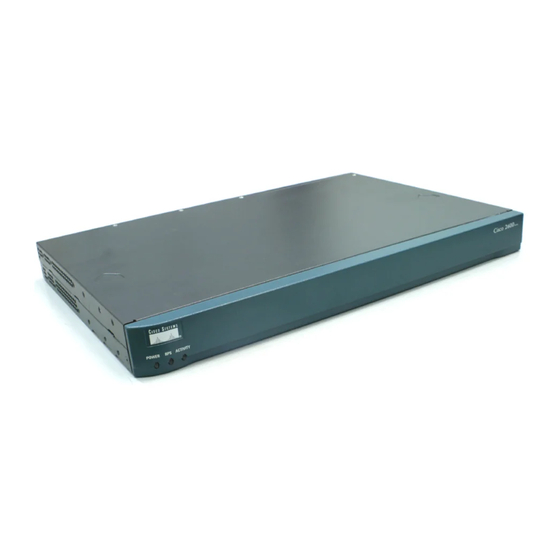Cisco 2691 Series Hızlı Başlangıç Kılavuzu - Sayfa 22
Ağ Yönlendiricisi Cisco 2691 Series için çevrimiçi göz atın veya pdf Hızlı Başlangıç Kılavuzu indirin. Cisco 2691 Series 29 sayfaları. Modular routers
Ayrıca Cisco 2691 Series için: Yükleme ve Biçimlendirme (34 sayfalar), Veri Sayfası (8 sayfalar), Kullanıcı Kılavuzu (48 sayfalar)

For interface numbering information, see the "Interface Numbering" section on page 22.
Step 1
To proceed with manual configuration using the CLI, enter no.
Would you like to enter the initial configuration dialog? [yes/no]: no
Press Return to terminate autoinstall and continue with manual configuration.
Step 2
Would you like to terminate autoinstall? [yes] Return
Several messages are displayed, ending with a line similar to the following:
...
Copyright (c) 1986-2000 by cisco Systems, Inc.
Compiled <date> <time> by <person>
Press Return to bring up the Router> prompt.
Step 3
...
flashfs[4]: Initialization complete.
Router>
Step 4
Enter privileged EXEC mode.
Router> enable
Router#
Note
To avoid losing work you have completed, be sure to save your configuration occasionally as you proceed. Use the
copy running-config startup-config command to save the configuration to NVRAM.
For configuration using the CLI, refer to the applicable configuration procedures in the Software Configuration Guide:
Cisco 2600 Series, Cisco 3600 Series, and Cisco 3700 Series Routers. See the "Where to Go Next" section on page 23 for
information about accessing this document.
7
Interface Numbering
Each individual interface (port) on a Cisco 2691 router is identified by number as described in the following sections.
WAN and LAN Interface Numbering
The Cisco 2691 router chassis contains the following WAN and LAN interface types:
• Built-in LAN interfaces: Ethernet, Fast Ethernet, Token Ring
• Two or three slots in which you can install WAN interface cards (WICs)
• One slot in which you can install a network module
The numbering format is Interface-type Slot-number/Interface-number. Two examples are:
• Ethernet 0/0
• Serial 1/2
The slot number is 0 for all built-in interfaces and 0 for all WIC interfaces; the slot number is 1 for network module interfaces.
Interface (port) numbers begin at 0 for each interface type, and continue from right to left and (if necessary) from bottom to top.
Figure 10 shows a router with:
• A 2-port T1 network module in slot 1 (containing the following ports: T1 1/0 and T1 1/1)
• Two built-in Ethernet 10/100 interfaces—Fast Ethernet 0/0 and Fast Ethernet 0/1
22
